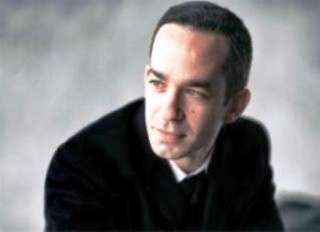|
Back
Painting Mahler With Ravishing Colors New York
David Geffen Hall, Lincoln Center
02/15/2017 - & February 16, 17, 18, 2017
Ludwig van Beethoven: Piano Concerto No. 1 in C Major, Opus 15
Gustav Mahler: Symphony No. 1 in D Major
Inon Barnatan (Pianist)
New York Philharmonic Orchestra Manfred Honeck (Conductor)

I. Barnatan (© Courtesy of the Artist)
”Nothing upsets an audience so much as not knowing whether to laugh or cry.”
Fredrich Löhr, on Mahler’s First Symphony
And yes, that comment by Mahler’s friend was true in 1894, when the “unconscious” was philosophical, not psychological, a decade before Anton met Sigmund. Yet today, Mahler’s emphasis that music must embrace the world, is not only accepted but should be relished.
As it obviously was by conductor Manfred Honeck last night in a breathtaking performance of the very first symphony, which goes by the erroneous title “Titan.” Not that the work isn’t titanic in every possible way, but that Mahler explores so much else here. And Mr. Honeck was the conductor who could do it.
I am not thinking of the finale, which, from the very first dissonant chord to the grand ending measures, invariably is an emotional ascension. But rather those enigmatic middle movements.
Mr. Honeck’s opening, granted, was like a very literal sunrise in the forest. The birdcalls, from offstage and on stage, did not come out of the mysterious depths of Mahler’s mind. They became avian music, out of Beethoven’s Pastoral or later any of Messiaen’s music.
But if one wanted that mystery, those clouds, then never mind. Mr. Honeck loves the first chair wind players of the Phil, and they cooed or chirped or trumpeted out our feathered friends, even as the clouds lifted, and the Mahler’s nature (or in this case, Mother Nature) set itself to come.
But now we came to the second movement, described as “with powerful movement, but not too quick”. That gives a lot of leeway, and Mr. Honeck took advantage of it, For this was one of the two Mahler dance movements here: the third movement folk-Jewish, this one folk-Austrian. And Mr. Honeck let himself go.
Some might have been annoyed at his changes of tempo, his exaggerated dance measures, a peasant dance on which no peasant could ever dance without falling down. I loved it. Like the avian first movement, it was painted literally, and was all the more exciting for that.
As for the Trio, Mr. Honeck offered a delicious contrast. Instead of our peasant dance, he gave a sultry languid, lap-dance. The violins slithered away, as if oblivious that this was serious Mahler. It was as if our peasant had fallen on his derrière and was dreaming of a lubricious heaven before rising up and trying to dance again.
Mr. Honeck, with his penchant for unleashing the orchestra, could have given a parody of the Jewish funeral in the third movement. He did nothing of the kind. The nursery tune was played straight, and the klezmer band was not played like a distortion of the funeral. It was simply the nature of the funeral–and a good picture of Mahler’s all-embracing mind.
The Finale might not be loved by the purists. Mr. Honeck took every advantage of every rubato, he made the inner-movement climaxes like final words, he milked it for all the emotion he could find.
And one has to ask why not? This was hardly the youthful Late Romantic Mahler. It was the work of a 30-year-old conductor/composer, whose mind was churning with paradoxical emotions, with tragedy and comedy and triumph in the same movement. And fortunately, there is no “right” way to conduct it. Mr. Honeck took it in his hands, exploiting–not abusing–the fervent notes and feelings of the composer.
Next to this performance–questionable or not–Beethoven’s First Concerto seemed somewhat pallid. An entertaining enough sketch executed by a more than competent draftsman. If one was emotionally drained by the end of Mr. Honeck’s Mahler, one felt merely satisfied by the performance of Israeli pianist Inon Barnatan.
When it comes to challenging recitals, he is more than equal to the task. Last year, Mr. Barnatan climbed a pianist’s Olympus, ascending to the heights of Bach-Busoni, Ligeti and the Brahms Handel Variations. When it came to the comparatively easy Beethoven C Major Concerto, he let it roll off his fingers without a thought.
Or without insight either. I believe that Mr. Honeck caught those variegated Beethoven moods with the Philharmonic. Jesting, tormenting, stormy and childishly impish at the finale. Listening to the orchestra, one felt that Beethoven was breaking the Classical strictures by changing temperaments every few measures (save for the slow movement).
Mr. Barnatan might not have been feeling that singularity. Instead of a Beethoven romp for his first Concerto, Mr. Barnatan played a well-tempered clavier. His technique is fabulous (the chordal trills in the original Beethoven cadenzas were perfect), yet one felt that it was all too proper, that the speed of the final Allegro didn’t give much room for Beethoven’s little jokes, and that he was not terribly interested in the results.
That could not be said for Mr. Honeck. Whether in the First Concerto or the Mahler First Symphony, he relished the emotions, was not afraid to exaggerate when necessary and memorablyh painted both pieces with dazzling colors and a very broad brush.
Harry Rolnick
|